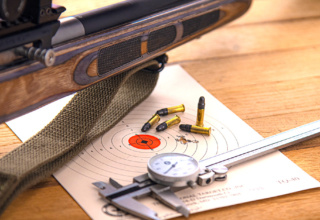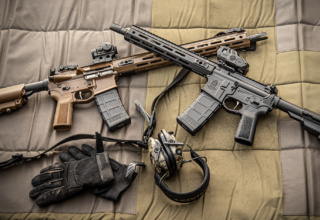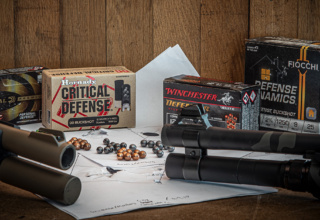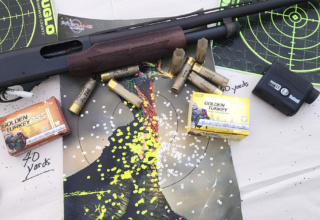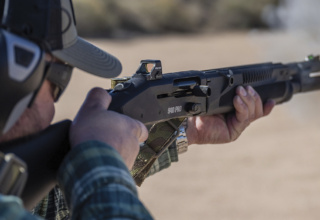Technology is a great equalizer, but skill development and the thrill of the hunt come at CLOSE distances
by Larry Case
He was fifty steps away and nervous as a long-tailed cat at a rocking chair festival. After a long hour’s wait, the cagey old gobbler stepped around an old chestnut log and showed himself. He was looking for the hen he had been hearing and, not seeing her, was only making things worse. Doing the textbook antsy gobbler act, walking in little circles with exaggerated head bobs, I could practically feel his gaze in my direction. I knew this turkey was getting ready to change his address. I was ready. I was facing him slightly to my left, the shotgun was up, and I had a bead on his neck — a moving target at best.
I could shoot at this turkey; I almost surely would hit him, and I may kill him. The problem was that little voice in my head was telling me to not put any more pressure on the trigger. Fact is, I just couldn’t be sure I would make a clean kill at this range, and a chaotic, running chase on a wounded turkey didn’t seem like a good way to spend the rest of the morning.
I let him walk.
Now I know what many of you are thinking. With whatever current nuclear turkey load and choke you are using you would not have hesitated on this shot. Well, I was there, I made the call, and I am fine with it. All of this makes me think a little about where we are in the turkey hunting world.
The Long and the Short of It
It really has not been that long ago when we would not have been having this discussion. Shotgun loads for turkeys or anything else were all roughly the same. New developments in recent years have changed the landscape of turkey hunting and other shotgun sports. We hear a lot of talk with respect to yardage in the field and how “60 is the new 40.” Tungsten Super Shot (TSS) came on the scene as a commercially available turkey load a few years ago and the earth tilted slightly on its axis. TSS is not new and has been handloaded by a shadowy group of acolytes for many years. When it became commercially available, all the hoopla started with TSS.
Tungsten Super Shot, no doubt, outperforms lead at extended ranges, with a size #9 pellet of tungsten having the same performance, distance, and penetration as a #5 made of lead. When you do the math of #9s versus #5s, the number of shot loaded in a shell is about double. All of this comes at a price — all the tungsten used for commercial purposes is mined in China, and it ain’t cheap. A box of five turkey loads in 12 gauge is often priced well north forty bucks.
So, if you see where I am going here, if you do not intend to stretch the barrel of your shotgun and aim to keep your shots on turkeys inside of forty yards, do you need to be shooting TSS? Is a turkey with, say, fifteen to twenty hits in the head and neck from a traditional lead load not as dead when he hits the ground as one that is shot with a TSS load and receives twice that many? How dead can you kill a gobbler?
A Case for the Traditional Approach
Before TSS moved the yardage bar, there was a simpler time when it seemed more turkey hunters concentrated on calling gobblers and getting them in close rather than just shooting turkeys at most any distance. The setting up on a turkey, the calling, and mastering the art of sitting still was the focus of the hunt. Fooling an old mossback gobbler on his home court by enticing him into almost handshaking distance was how you won your spurs as a turkey hunter.
Times change, but what about other shotgun loads that may be suitable at normal hunting ranges and not cost as much as filling up your truck at the gas pump?
The Shotgun Ammo That You Have Wondered About
You have seen it on the shelf in the gun store. You may have thought about trying it but you weren’t sure how to say the name on the box, so you passed it by.
Fiocchi (FEE-O-KEE) has been making ammunition for a long time, like since 1876, when company founder Giulio Fiocchi took over an ammunition business in Italy. Also, for all those suspicious of anything not made in the US of A, Fiocchi USA has been cranking out ammunition at their factory in Missouri since the 1980s, with 75% of all ammo and 100% of their shotgun ammo sold in the United States being made here.
Fiocchi has long had a reputation with competitive shotgun shooters in all disciplines, from Olympic trap and skeet to the many forms of competitive shotgun, international and domestic. Serious shotgun competitors are not ones to tolerate any shortcomings in ammunition. They can’t afford to. They practice too hard and too much is at stake to have a failure in ammunition. Many of these shotgun competitors choose Fiocchi ammunition. If world-class competitive shooters choose Fiocchi shotgun ammo, maybe a turkey hunter should, too?
The Sum of Many Parts
Good shotgun shells, like a lot of things, are made of many parts. As with any ammo, it all starts with a primer. Many shotgun ballisticians and avid shooters consider Fiocchi primers one of the most reliable, consistent 209 primers around. The importance of good primers cannot be overemphasized. The primer has to ignite the shell every time or the gun will not go BOOM.
The gunpowder in Fiocchi shells is double-based American-made powder. Double-based powder is less susceptible to moisture, which lends to more consistent and reliable velocities. All this means more consistent patterns on paper and on turkeys.
The wad in a shotgun shell is also important. For that, Fiocchi uses premium, proprietary wads. Most hunters don’t consider how important the wad is in a shotgun shell. Made of resin, these softer and stronger wads, like the powder, lend to better patterns and performance in the field.
Several years ago, Fiocchi bought the Italian company Cervo, which was making nickel electroplated shot. Nickle-plated shot will generally outperform plain lead or copper-plated shot because it is hard and less likely to deform and blow out patterns. Nickel-plated loads may very well out-shoot more expensive buffered turkey loads. What turkey hunters want, of course, is penetration — the terminal performance of the shot once it hits a turkey. Nickel-plated shot, like those used in Fiocchi shotshells, will consistently penetrate equal to or more than copper-plated buffered loads.
Attention to detail on shot, wad, and powder make for a good shotgun shell.
Where It Matters
All of this is well and good, but what really matters is what happens when you pull the trigger on your shotgun. On the range, I found the Fiocchi Golden Turkey loaded, fed, and fired without a hitch in three different shotguns — the Remington V3 Turkey Pro semi-auto, a CZ-USA over and under Upland Ultralight All-Terrain model, and a Remington 870 pump gun. The Golden Turkey loads were certainly not lacking in powder and the empty hulls ejected a healthy 8-10 feet from the gun in the V3. The empty hulls, likewise, flew a respectable distance from the port of the Remington 870. No problems with feeding or ejecting.
As noted here before, finding the “best” shotshell and choke combination for your shotgun is a matter of experimentation, or as much as your checkbook and shoulder can stand. The target used was the now standard 10-inch circle at 35 yards, as well as a TRUGLO turkey head target. In the Remington 870 and the V3, I found the TRUGLO Gobble Stopper choke and a Sumtoy brand choke shot very well. In the CZ-USA shotgun, a TruLock choke out-shot everything else we tried in it with the Fiocchi Golden Turkey loads.
By my count, there are ten different Golden Turkey loads on the Fiocchi USA website comprised of 3-inch and 3.5-inch rounds in #4, #5, and #6 size shot. Most likely, you will find a load that your shotgun likes. At around ten bucks for a box of ten, you can test some different loads without breaking the bank. The Golden Turkey 3-inch, 1 ¾ ounces of #5 shot has a listed feet per second velocity of 1325, and that, my friends, is moving. Speed kills, and between that kind of velocity and the nickel-plated shot, this ammo could be a gobbler’s worst nightmare.
What the future may hold for turkey hunting in general I am not sure. Who knows what new developments in shotshell ammo may come down the road? I do not see how yardages can increase with what you may do with a shotgun, but we shall see. If you would like to consider returning to your roots and calling turkeys to closer encounters, maybe you should give the Fiocchi Golden Turkey ammo a look.






